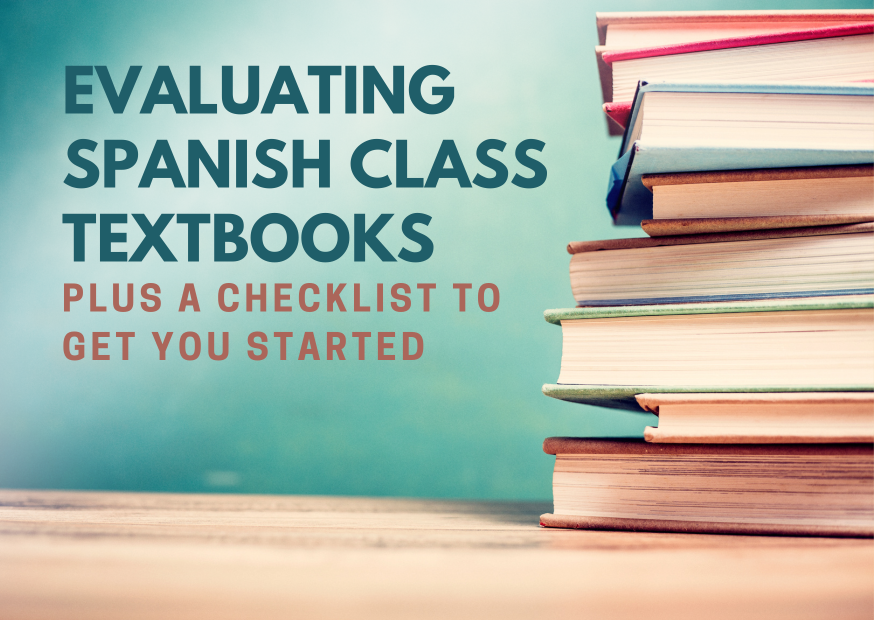
If your school lets you choose your Spanish class textbook, it might feel a bit nerve-wracking to pick the right one. Textbooks are a big deal for schools and districts, and this choice will stick with you for years. So, when you get the chance, it’s time to start the hunt for the perfect textbook: one that strikes the right balance between comprehensible input, explicit grammar instruction, engaging activities, and cultural relevance.
Luckily, we now have online spots where you can get honest feedback from real teachers to help narrow down your search. This thread from our World Language Teacher Lounge Facebook group is packed with useful insights from Spanish teachers. It is a goldmine and an excellent starting point in your search for a textbook. Here’s the scoop on what they said…
The Quest for Textbook Balance
A common gripe is that many newer textbooks cram too much into each unit, overwhelming students with excessive vocab and grammar concepts. Nancy S. complains about Entreculturas 2: “I never got to complete Unit 4, the food section, and had to rush through the preterite vs. imperfect in Unit 5. The authentic cultural resources are nice, but a lot of the vocab is stuff the students don’t need at this point.”
On the flip side, some teachers feel older series like Avancemos and Asi Se Dice are better paced but lack updated cultural content. As Eileen F. puts it bluntly, “Avancemos is so old.”
The Need for Flexibility
Flexibility seems to be a key desire, with many praising series like Reporteros by Klett World Languages for allowing different teaching styles. Cassandra D. writes: “It allows different teachers to approach teaching differently, all while teaching the same material. Each unit offers traditional assessments, as well as IPAs and project-based assessments.”
Diego Ojeda, a fan, exclaims: “No match for Reporteros by Klett World Languages and they are super generous!”
Established Spanish Textbook Favorites
 Here are some popular series that received good reviews:
Here are some popular series that received good reviews:
- Descubre/Senderos (Vista Higher Learning): “I really like it! I create my own slide presentations and in class activities, and then assign the Vistas activities for homework, and use their assessments. Planning and grading is so easy!” raves Michele P.
However, others like Tina N. “hate it” due to the excessive vocabulary load.
- Asi Se Dice (Carnegie Learning): While dated, Sara P. “I feel like they are quite proficiency oriented despite their age.”
- Realidades (Pearson): A solid option according to Ada M.: “Realidades is great I love it.”
Spanish Class Textbooks List for Consideration
Here’s a table summarizing the pros and cons for each textbook based on the comments by Spanish teachers:
| Textbook | Pros | Cons |
|---|---|---|
| Voces Nuestra Historia | – | Lacking in vocabulary and direct grammar instruction |
| Somos | Natural, proficiency-based approach | Ruled out for “various reasons” by original poster |
| Entreculturas | Authentic cultural resources | Too much vocabulary, grammar packed into units |
| Avancemos | Well-paced | Dated cultural content |
| Asi se dice | Well-paced, proficiency-oriented despite age | Dated |
| Senderos/Descubre (VHL) | Comprehensive, good online resources/assignments | Excessive vocabulary load, grammar progression too fast |
| Exploremos | Looks promising (little detail provided) | – |
| Auténtico | – | Platform called “buggy” |
| Qué chevere | – | Ruled out (reason not stated) |
| Reporteros (Klett) | Flexible for different teaching styles, engaging | Expensive |
| Santillana | – | No details provided |
| Encuentros (VHL) | – | One teacher plans to not use it |
| Realidades | “Great” per one teacher | – |
| Mapas | – | Middle school students disliked serious content |
| Exploraciones | Liked by one college instructor | – |
| Vistas | Good for college, loved online platform/auto-grading | – |
| Temas | Liked for AP course | – |
Of course, no textbook discussion would be complete without disagreement. While Magali M. is a fan of the proficiency-based Somos for its natural approach, the author of the post ruled it out for “various reasons.”
And then there’s Richard H., who confidently declares: “Our district just adopted Encuentros. It’ll sit on a shelf and collect dust in my classroom. I haven’t used a textbook since 2012.”
As Jamie A. wisely states, “A book isn’t a curriculum.” But for many of us, an adaptable, well-designed textbook can provide a solid framework to build engaging, comprehensive lessons.
Why Spanish Teachers Struggle to Find the Right Textbook
 According to what teachers commented, we identify five top challenges when selecting a textbook:
According to what teachers commented, we identify five top challenges when selecting a textbook:
- Balance of grammar, vocabulary, and comprehensible input
Many teachers felt that newer textbooks tried to pack in too much vocabulary and explicit grammar instruction per unit, making it overwhelming for students. However, they also criticized some older textbook series for lacking enough direct grammar practice. Finding the right balance of comprehensible input and explicit instruction is challenging. - Authentic cultural relevance
While appreciating authentic cultural readings and videos, some teachers found the content in certain textbooks to be dated or not realistically appropriate for the proficiency level. Keeping cultural lessons engaging and level-appropriate is difficult. - Flexibility for different teaching styles
With communicative language teaching and proficiency-based approaches becoming more popular, some teachers wanted textbooks that allowed flexibility for different instructional methods like CI/TPRS rather than forcing one rigid approach. Having room for teachers to adapt was important. - Pacing and depth
Teachers disagreed on whether textbooks tried to cover too little or too much material. Some felt yearly pacing guides were unrealistic, while others thought books were shallow. Getting the right depth of content with reasonable pacing goals is tough. - Lack of assessments/activities
While online components were appreciated, some textbooks lacked quality assessments or classroom activities, forcing teachers to create their own supplemental materials.
Textbook Evaluation Checklist for Spanish Teachers
Balance of Vocabulary and Grammar Instruction
- Does the textbook provide ample vocabulary practice?
- Is there explicit grammar instruction?
- Is the content balanced without being overwhelming in each unit?
Integration of Proficiency and Communicative Approaches
- Does the textbook support proficiency-based instruction?
- Can the textbook accommodate different teaching styles, such as comprehensible input (CI) methods?
- Does it avoid a rigid, grammar-translation approach?
Authentic and Engaging Cultural Content
- Are the cultural readings, videos, and activities up-to-date?
- Is the cultural content level-appropriate and engaging for students?
- Does the textbook avoid using dated cultural material?
Reasonable Pacing and Depth
- Is there a logical progression and pacing of material?
- Does the textbook cover an appropriate amount of content per level?
- Is the content neither too superficial nor too overwhelming?
Quality Assessments and Classroom Activities
- Does the textbook include quality assessments?
- Are there communicative activities provided?
- Are there sufficient teacher resources to reduce the need for supplemental materials?
Online/Technology Integration
- Are there quality online components included?
- Does the textbook offer auto-graded assignments?
- Are digital resources available and effective?
Flexibility to Supplement
- Is the core textbook solid enough to stand on its own?
- Can you easily supplement with outside materials for different skills or teaching styles?
What to Do If You’re Stuck with a Spanish Textbook You Don’t Like
If the textbook assigned by the school isn’t the one you like, here are a few tips to consider:
Supplement and Adapt Extensively – A lot of teachers in the thread mentioned heavily supplementing and adapting the assigned textbook to better fit their needs. This includes:
- Creating their own activities, assessments, and projects to replace or enhance sections they don’t like
- Pulling in authentic resources to boost the cultural content
- Re-arranging or tweaking the pacing and sequence of units
- Skipping vocabulary lists or grammar explanations that aren’t effective
Use the Textbook as a General Framework – Some teachers suggested using the textbook as a loose guide for overall themes and topics, but essentially creating their own curriculum around it. As Richard H., said, “It’ll sit on a shelf and collect dust in my classroom.”
Ask for a Textbook Review – If a lot of teachers are unhappy with the current book, they could push for a formal textbook review and adoption process to choose a new program. Providing solid evidence of the current book’s shortcomings is crucial.
Only Use the Online Resources – For textbooks with strong digital platforms, teachers can sometimes just use the online resources (like assessments, audio/video, and practices) they find valuable while ignoring the physical textbook.
Use Multiple Textbook – Some teachers mentioned mixing and matching resources from multiple textbooks to create the best curriculum instead of sticking to just one program.
So, add your vote to the thread! What textbooks have worked for your Spanish classroom?